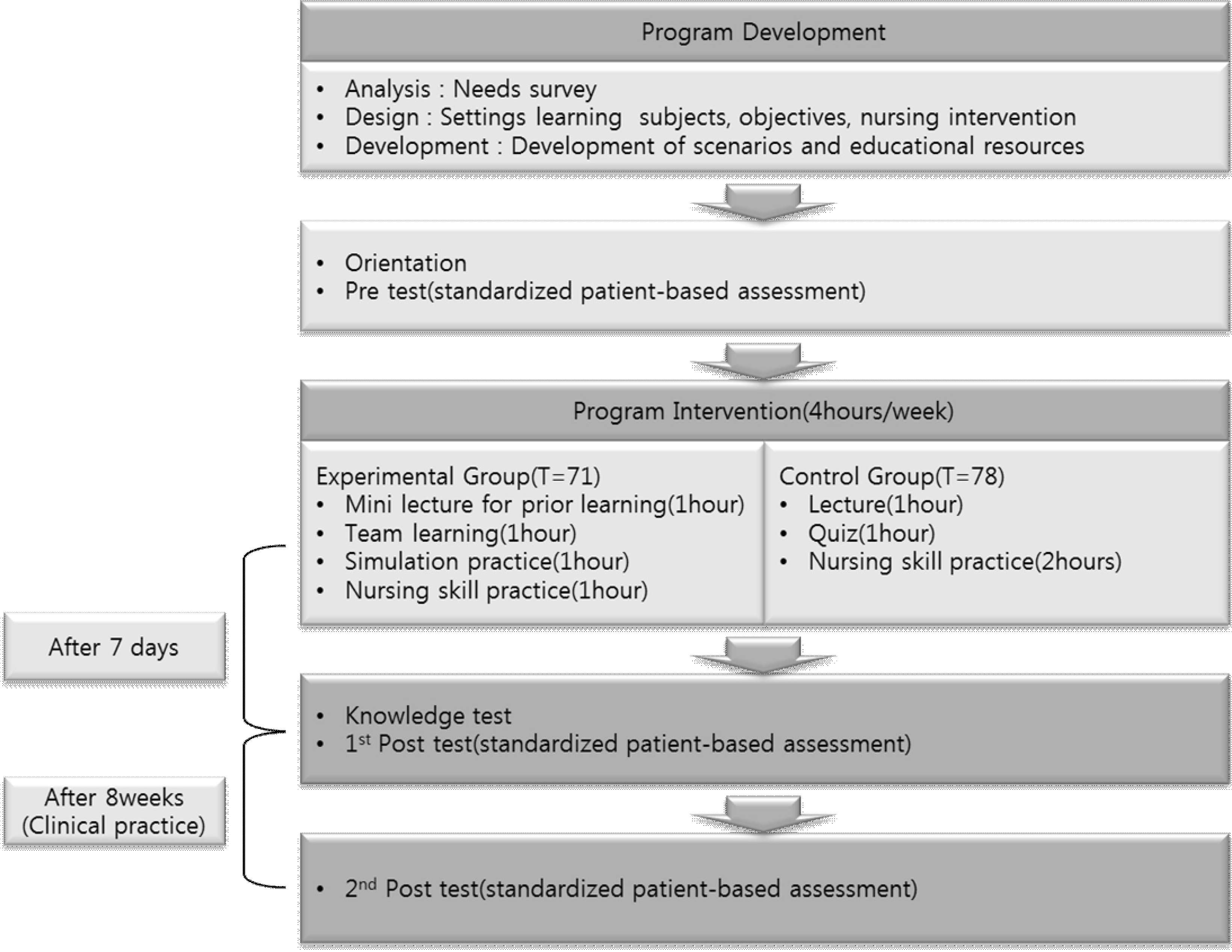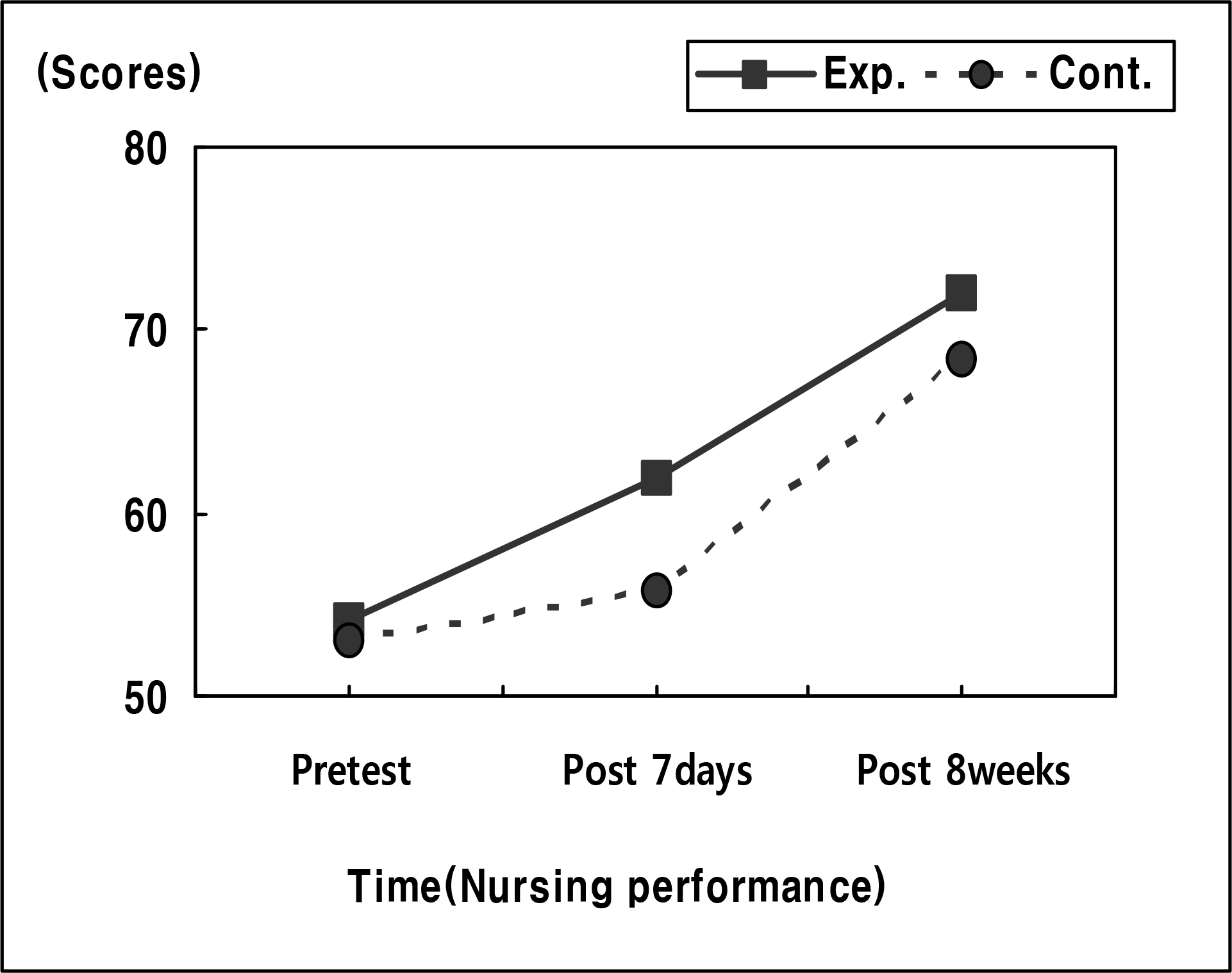Abstract
Purpose
The purposeof thisstudywas toevaluatetheeffectsof acolonoscopysimulationprogramonknowledge and clinical performance amongnursingstudents. Methods: The program consistedof ascenariowith threeob-jectives: health assessment, nursing before/after colonoscopy and emergency care for bleeding following the colonoscopy. Anonequivalent control grouppretest-posttest designwas used. The samplewas 149nursingstu-dents recruited from H University in G city from August, 2013 to December, 2014. The treatment group (n=71) receivedthesimulationandthecomparisongroup(n=78)receivedtheusual lectureprogram. Datawere analyzed using descriptive statistics, x2 test, t-test and repeated measure ANOVA using the SPSS/WIN 20.0 program. Result: Participants in the treatment group had significantly increased reported scores on both knowledge and clinical performance. Conclusion: Results indicate that the simulated program is a useful strategy for improving knowledge and clinical performanceamongnursingstudents. The development of simulationpractice programs in a variety of fields are needed in order to promote the practical competence of nursing students.
Go to : 
REFERENCES
1.Liaw SY., Chan SW., Chen FG., Hooi SC., Siau C. Comparison of virtual patient simulation with mannequin-based simulation for improving clinical performances in assessing and managing clinical deterioration: randomized controlled trial. Journal of Medical Internet Research. 2014. 16(9):e214. http://dx.doi.org/10.2196/jmir.3322.

2.Jho MY. An analysis of research on nursing practice education in Korea. The Journal of Korean AcademicSociety of Nursing Education. 2010. 16(2):239–48.

3.Kwon YJ., Son SS., Lim YD. The rights ofpatients as consumers. Health Policy and Management. 2012. 22(3):315–46. http://dx.doi.org/10.4332/KJHPA.2012.22.3.315.
4.Song JH., Kim MW. Study on clinical education for nursing in hospitals in Korea. The Journal of Korean Academic Society Of Nursing Education. 2013. 19(2):251–64. http://dx.doi.org/10.5977/jkasne.2013.19.2.251.

5.Sin KM., Kwon JO., Kim EY. Factors associatedwith newgradu-ate nurses'reality shock. The Journal of Korean Nursing Administration Academic Society. 2014. 20(3):293–302. http://dx.doi.org/10.11111/jkana.2014.20.3.292.
6.Son SS., Yang SJ. Job stress and job satisfaction among nurses in gastrointestinal endoscopy units. Journal of Korean Clinical Nursing Research. 2014. 20(2):189–99.
7.Lee SJ., Park YM., Noh SM. The effects of simulation training with hybrid model for nursing students on nursing performance ability and self confidence. Korean Journal of Adult Nursing. 2013. 25(1):170–82. http://dx.doi.org/10.7475/kjan.2013.25.1.170.

8.Park JS. Certification standards for an accreditation of nursing education. Presentation meeting for Nursing Education Accreditation Evaluation in 2012;2012 March 15; Catholic Research Institute of Medical Science Auditorium. Seoul: Korean Accreditation Board of Nursing Education;2012. p. 111–41.
9.Ballangrud R., Persenius M., Hedelin B., Hall-Lord ML. Exploring intensive care nurses' team performance in a simulation-based emergency situation,-expert raters' assessments versus self-assessments: an explorative study. BioMed Central Nursing. 2014. 13(1):47. http://dx.doi.org/10.1186/s12912-014-0047-5.

10.Powell-Laney S., Keen C., Hall K. The use of human patient simulators to enhance clinical decision-making of nursing students. Education for Health. 2012. 25(1):11–5.

11.Meyer MN., Connors H., Hou Q., Gajewski B. The effect of simulation on clinical performance: a junior nursing student clinical comparison study. Journal of the Society for Simulation in Healthcare. 2011. 6(5):269–77. http://dx.doi.org/10.1097/SIH.0b013e318223a048.
12.Aqel AA., Ahmad MM. High-fidelity simulation effects on CPR knowledge, skills, acquisition, and retention in nursing students. Worldviews on Evidence-based Nursing. 2014. 11(6):394–400. http://dx.doi.org/10.1111/wvn.12063.

13.Arafeh JM. Simulation-based training: the future of competency? Journal of Perinatal and Neonatal Nursing. 2011. 25(2):171–4. http://dx.doi.org/10.1097/JPN.0b013e3182116e55.
14.National Cancer Information Center. National cancer statistics. [Internet]. Seoul: National Cancer Information Center;2012. [cited 2013 August 10]. Available from:. http://www.cancer.go.kr/mbs/cancer/subview.jsp?id=cancer_040102000000.
15.Anderloni A., Jovani M., Hassan C., Repici A. Advances, problems, and complications of polypectomy. Clinical and Experimental Gastroenterology. 2014. 30(7):285–96. http://dx.doi.org/10.2147/CEG.S43084.
16.Lee SH., Park YK., Lee DJ., Kim KM. Colonoscopy procedural skills and training for new beginners. World Journal of Gastroenterology. 2014. 20(45):16984–95. http://dx.doi.org/10.3748/wjg.v20.i45.16984.

17.Lin OS. Performing colonoscopy in elderly and very elderly patients: risks, costs and benefits. World Journal of Gastrointestinal Endoscopy. 2014. 6(6):220–6. http://dx.doi.org/10.4253/wjge.v6.i6.220.

18.Lee YJ., Hong EJ., Kim SO., Kim HS., Yang IS., Cha KH, et al. Effects of walking on discomfort and colon cleansing during colon lavage before colonoscopy. Journal of Korean Clinical Nursing Research. 2010. 16(1):39–49.
19.Trevisani L., Zelante A., Sartori S. Colonoscopy, pain and fears: is it an indissoluble trinomial? World Journal of Gastrointestinal Endoscopy. 2014. 6(6):227–33. http://dx.doi.org/10.4253/wjge.v6.i6.227.

20.McIntosh KS., Gregor JC., Khanna NV. Computer-basedvirtual reality colonoscopy simulation improves patient-based colonoscopy performance. Canadian Journal of Gastroenterology & Hepatology. 2014. 28(4):203–6.
21.White I., Buchberg B., Tsikitis VL., Herzig DO., Vetto JT., Lu KC. A virtual reality endoscopic simulator augments general surgery resident cancer education as measured by performance improvement. Journal of Cancer Education. 2014. 29(2):333–6. http://dx.doi.org/10.1007/s13187-014-0610-5.

22.Yoo SY. Development and effects of a simulation-based education program for newborn emergency care. Journal of Korean Academy of Nursing. 2013. 43(4):468–77. http://dx.doi.org/10.4040/jkan.2013.43.4.468.

23.TheKorea Societyof Coloproctology. Colonoscopy. [Internet]. Seoul: The Korea Society of Coloproctology;2013. [cited 2013 August 2]. Available from:. http://www.colon.or.kr/colonlife/story/index.kin?mode=view&uid=62&no=31&page=1&search=&search_text=&subid=1.
24.Han WJ., Kim YJ., Kim JG., Kim TG., Lee SY., Cho MS, et al. Risk factors for delayed bleeding after colonoscopic polypectomy. The Korean Journal of Gastrointestinal Endoscopy. 2010. 40(3):164–9.
25.Parmelee D., Michaelsen LK. Team-based learning: it's here and it WORKS! Academic Medicine. 2010. 85(11):1658–9. http://dx.doi.org/10.1097/ACM.0b013e3181f55a35.

26.Shin MJ., Ahn SH., Lee MA. Team-spirit experiences for new nurses through off-the job training. The Journal of Korean Academic Society Of Nursing Education. 2008. 14(1):108–16.

27.Lee CK., Ling YY., Leng LW., Chang SY. Comparing effectiveness of high-fidelity human patient simulation vs case-based learning in pharmacy education. American Journal of Pharmaceutical Education. 2014. 78(8):153. http://dx.doi.org/10.5688/ajpe788153.
28.Kim JH., Park IH., Shin SJ. Systematic review of Koreanstudies on simulation within nursing education. The Journal of Korean Academic Society Of Nursing Education. 2013. 19(3):307–19. http://dx.doi.org/10.5977/jkasne.2013.19.3.307.
Go to : 
Table 1.
Learning Subjects, Objectives, Core Nursing Intervention Of the Scenario
Table 2.
Homogeneity Test on Demographic and Clinical Characteristics of Subjects (N=149)
Table 3.
Comparison of Nursing Performance between the Groups (N=149)
| Variables | Groups | Exp. (n=71) | Cont. (n=78) | t† | p | Source | F‡ | p |
|---|---|---|---|---|---|---|---|---|
| M±SD | M±SD | |||||||
| Knowledge | Post 7 days | 8.18±1.13 | 6.52±1.61 | 11.94 | < .001 | |||
| Clinical | Pretest | 54.07±5.96 | 53.05±4.99 | 1.14 | .258 | Group | 194.58 | < .001 |
| Performance | Post 7 days | 61.92±7.90 | 55.87±5.47 | 8.94 | < .001 | Time | 176.55 | < .001 |
| Post 8 weeks | 72.07±3.77 | 68.41±4.82 | 23.35 | < .001 | Group×Time | 101.01 | < .001 |




 PDF
PDF ePub
ePub Citation
Citation Print
Print




 XML Download
XML Download